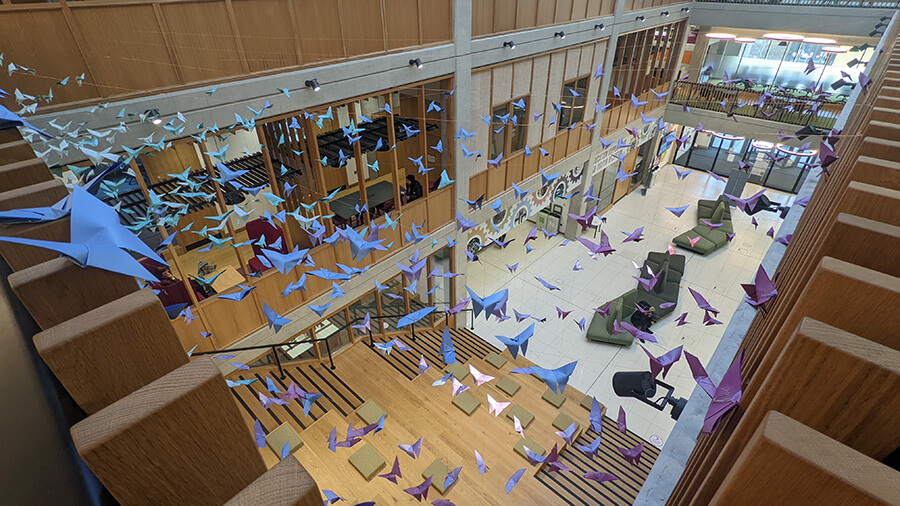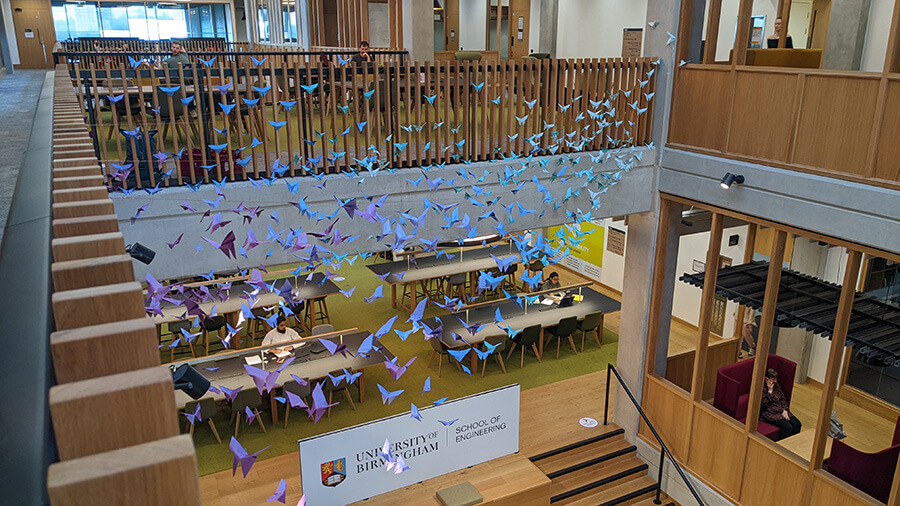Students, staff and members of the public were encouraged to create an origami butterfly as part of an art exhibition reflecting on the impact COVID-19 had on our mental health.

The exhibition ran from 21 March 2022 at the University of Birmingham's School of Engineering building (campus maps and directions), marking the second anniversary of the first lockdown due to COVID-19.
The exhibition features over 500 origami butterflies of five different colours. Each colour represents how the pandemic made someone feel, from lonely and anxious through to grateful and united.

The exhibition aimed to provide people with a mindful space to create origami art and reflect on how the pandemic made them and other people feel. People also had the opportunity to learn about engineering and mathematical origami and the work we do here in the Shape Transforming Active Microfluidics research group.
Attendees had some mindful time whilst making the origami butterflies. When the exhibition was up hopefully they saw it and realised how many other people feel like they do and were comforted by this.

How to make an origami butterfly

Step-by-step instructions for making your own origami butterfly
Additional information
Shape-Transforming Active Microfluidics (STAM)
The Butterfly Effect exhibition formed part of the Leverhulme Trust funded project "Shape-Transforming Active Microfluidics". The project was led by Professor Tom Montenegro-Johnson, who was a Professor in Applied Mathematics at the University of Birmingham's School of Mathematics.
As well as the response to the question, these butterflies represent the movement of a group of particles. Here in the shape-transforming active microfluidics research group (STAM for short) we look at modelling particle movement to understand materials for use in biomedicine. Our main research material is hydrogel (the material contact lenses are made from). Some specific types of hydrogels, a type of smart active matter, can change shape when there is a change in temperature by expelling fluid. We are looking to combine these shape-transforming hydrogels with origami principles to create new ideas and devices.
Origami in engineering and mathematics
Origami is already being investigated and used to aid many different areas of engineering due to its usefulness in deployable technology and simple design from the folding of a single sheet of material. NASA have been testing out different ideas of using origami to pack and deploy solar arrays on satellites.
Origami in packaging has won awards for its ingenuity: a football packaging system won the Dieline Award for addressing a Nike equipment challenge. The designers found a packaging solution for football packaging which was efficient and sustainable by using origami. Origami has also been looked to for shape changing buildings due to its beautiful yet functional nature. This is talked about by Reis et al. in their PNAS commentary on ‘Transforming architectures inspired by origami’.
Moreover, origami has links to mathematics. The crease pattern, the pattern of lines left over when an origami model (for example a crane) is folded and then unfolded, can be looked at mathematically by thinking about it as a connection of lines and nodes. These ideas were explored by one of the creators of mathematical origami, Robert Lang, who has worked with origami for over fifty years. He has used these mathematical ideas to link back to engineering, creating devices ranging from airbags to expandable space telescopes.
Links to topology
Topology is a section of mathematics which looks at “geometric objects that are persevered under continuous deformations (e.g. stretching or twisting)”. This is a fancy way to say that no holes are closed or opened when you change the shape of the object. A classic example is if you take a mug and deform it without changing how many holes there are you can get the shape of a doughnut.
The art of origami, whereby a single sheet of paper is deformed to create another shape, preserves topological rules as no holes in the paper are created when the paper is folded. Origami also has links to topology through the crease pattern seen when a design is folded and then unfolded; see the picture for the lines which make up the folds of the origami butterfly. This can be linked to a mathematical graph, a connection of nodes via lines.
Funding
The Butterfly Effect project was primarily funded by The Leverhulme Trust with additional funds provided from the EPSRC Centre for Doctoral Training in Topological Design here at the University of Birmingham.